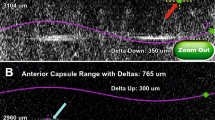Summary
In special forms of complicated secondary cataract, especially after a cataract operation in eyes with proliferative disease and after a cataract operation associated with pars plana vitrectomy and silicone oil instillation, surgical capsulotomy must be performed.
Methods: We developed a new surgical technique for posterior capsulorhexis via pars plana by using the high-frequency capsulotomy method developed by Klöti. We analyzed 14 consecutive patients undergoing late pars plana capsulotomy using a specially designed instrument for radiofrequency capsulorhexis. The indication for surgical capsulotomy was extreme secondary cataract; in 6 eyes fibrosis was associated with vascularizations.
Results: The high-frequency technique for posterior capsulotomy allowed reliable and precise tissue cutting. The cutting required minimal application of pressure to the capsule, and therefore damage to zonula fibers is minimized. Furthermore, use of the radiofrequency technique permitted hemostatic incision in vascularized membranes by inducing a fine coagulation margin.
Conclusions: Posterior capsulorhexis using radiofrequency offers precise and effective tissue cutting if surgical capsulotomy is necessary.
Zusammenfassung
Hintergrund: Nach Kataraktoperationen im Rahmen einer Pars plana-Vitrektomie mit Silikonölinstillation und bei proliferativen Erkrankungen können sehr dichte und z. T. vaskularisierte Kapseltrübungen entstehen, die eine chirurgische Kapsulorhexis erfordern.
Patienten und Methode: Wir entwickelten eine spezielle operative Technik für die posteriore Kapsulorhexis via Pars plana unter Verwendung des von Klöti entwickelten Hochfrequenzkapsulotomiegerätes. Wir analysierten 14 Augen, bei denen unter Verwendung eines speziell für diesen Eingriff geformten Instrumentes die posteriore Hochfrequenzkapsulorhexis erfolgte. Indikation für die Kapsulorhexis waren extrem dichte Kapseltrübungen, die bei 6 Patienten Vaskularisationen aufwiesen.
Ergebnisse: Der Einsatz der Hochfrequenztechnik ermöglichte bei allen Patienten die Durchführung einer exakten posterioren Rhexis. Das Durchtrennen des membranösen Gewebes erfolgt bei minimaler Krafteinwirkung auf die Zonulafasern. Vaskularisierte Membranen können hämostatisch durchtrennt werden.
Schlußfolgerung: Die Hochfrequenzkapsulotomie ermöglicht bei komplizierten Formen einer Kapselfibrose die Durchführung einer sicheren und präzisen posterioren Kapsulorhexis.
Similar content being viewed by others
Author information
Authors and Affiliations
Rights and permissions
About this article
Cite this article
Meier, P., Pittasch, K. Posterior high-frequency capsulotomy via pars plana. Ophthalmologe 95, 534–536 (1998). https://doi.org/10.1007/s003470050311
Published:
Issue Date:
DOI: https://doi.org/10.1007/s003470050311




